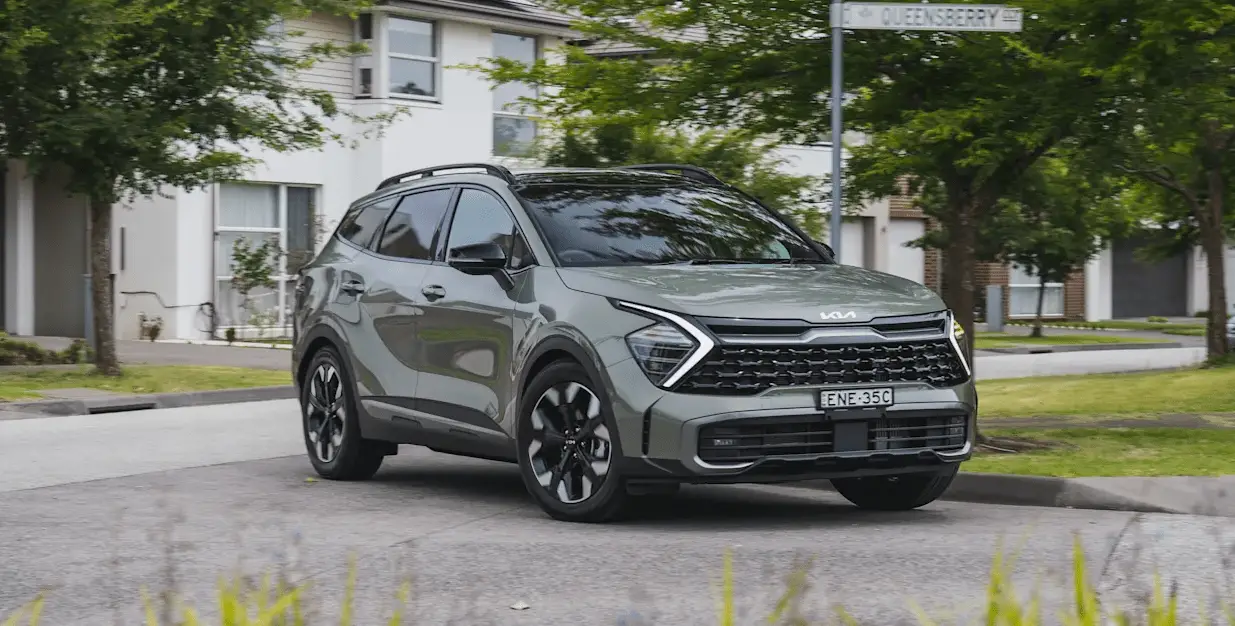 2022 Kia Sportage Child Restraint System (CRS) Specs
2022 Kia Sportage Child Restraint System (CRS) Specs
The 2022 Kia Sportage is a dynamic and safety-focused car, and the Child Restraint System (CRS) shows that Kia is always committed to keeping the youngest riders safe on their trips. The Sportage’s CRS is a perfect mix of innovation and care, made with painstaking attention to detail and a deep understanding of how to keep kids safe. It not only meets strict safety standards, but it also has thoughtful features like adjustable harnesses, multiple installation choices, and compatibility with different child seat sizes to make sure that every child traveller is safe and comfortable. We are going to take a deep look into the 2022 Kia Sportage’s Child Restraint System to find out all of its important features and how they work. This will help keep kids safe and give families peace of mind while driving this great SUV.
2023 KIA SPORTAGE Specs, Price, Features, Mileage and Torque
Selecting a Child Restraint System
When selecting a CRS for your child, always:
- Make sure the CRS has a label certifying that it meets applicable Federal Motor Vehicle Safety Standards (FMVSS 213).
- Select a child restraint based on your child’s height and weight. The required label or the instructions for use typically provide this information.
- Select a child restraint that fits the vehicle seating position where it will be used.
- Read and comply with the warnings and instructions for installation and use provided with the child restraint system.
WARNING
Holding Children
Never hold a child in your arms or lap when riding in a vehicle. The violent forces created during a crash will tear the child from your arms and throw the child against the car’s interior. Always use a child restraint system which is appropriate for your child’s height and weight.
WARNING
Unattended Children
Never leave children unattended in a vehicle. The car can heat up very quickly, resulting in injuries to the child in the vehicle.
WARNING
Seat Belt Use
Do not use one seat belt for two occupants at the same time. This will eliminate any safety benefits provided by the seat belt to the occupants.
Child restraint system types
There are three main types of child restraint systems: rear-facing seats, forward-facing seats, and booster seats. They are classified according to the child’s age, height and weight.
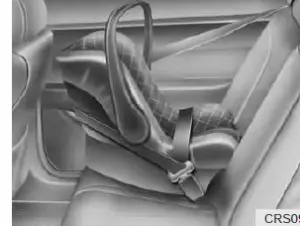
Rear-facing child seats
A rear-facing child seat provides restraint with the seating surface against the back of the child. The harness system holds the child in place, and in an accident, acts to keep the child positioned in the seat and reduces the stress to the neck and spinal cord.
All children under age one must always ride in a rear-facing infant child restraint.
Convertible and 3-in-1 child seats typically have higher height and weight limits for the rear-facing position, allowing you to keep your child rear-facing for a longer period of time.
Continue to use a rear-facing child seat for as long as your child will fit within the height and weight limits allowed by the child seat manufacturer. It’s the best way to keep them safe. Once your child has outgrown the rear-facing child restraint, your child is ready for a forward-facing child restraint with a harness.

Forward-facing child restraints
A forward-facing child seat provides restraint for the child’s body with a harness. Keep children in a forward-facing child seat with a harness until they reach the top height or weight limit allowed by your child restraint manufacturer.
Once your child outgrows the forward-facing child restraint, your child is ready for a booster seat.
Booster seats
A booster seat is a restraint designed to improve the fit of the vehicle’s seat belt system. A booster seat positions the seat belt so that it fits properly over the lap of your child.
Keep your child in a booster seat until they are big enough to sit in the seat without a booster and still have the seat belt fit properly. For a seat belt to fit properly, the lap belt must lie snugly across the upper thighs, not the stomach. The shoulder belt should lie snug across the shoulder and chest and not across the neck or face. Children under age 13 must always ride in the rear seats and must always be properly restrained to minimize the risk of injury.
Installing a Child Restraint System (CRS)
After selecting a proper child seat for your child, check to make sure it fits properly in your vehicle. Follow the instructions provided by the manufacturer when installing the child seat. Note these general steps when installing the seat to your vehicle:
- Properly secure the child restraint to the vehicle. All child restraints must be secured to the vehicle with the lap part of a lap/shoulder belt or with the LATCH system.
- Make sure the child restraint is firmly secured. After installing a child restraint to the vehicle, push and pull the seat forward and from side to side to verify that it is securely attached to the seat. A child restraint secured with a seat belt should be installed as firmly as possible. However, some side-to-side movement can be expected.
- Secure the child in the child restraint. Make sure the child is properly strapped in the child restraint according to the manufacturer’s instructions.
Lower Anchors and Tether for Children (LATCH) System
The LATCH system holds a child restraint during driving and in an accident. This system is designed to make installation of the child restraint easier and reduce the possibility of improperly installing your child restraint. The LATCH system uses anchors in the vehicle and attachments on the child restraint. The LATCH system eliminates the need to use seat belts to secure the child restraint to the rear seats.
Lower anchors are metal bars built into the vehicle. There are two lower anchors for each LATCH seating position that will accommodate a child restraint with lower attachments.
To use the LATCH system in your vehicle, you must have a child restraint with LATCH attachments.
The child seat manufacturer will pro-vide you with instructions on how to use the child seat with its attachments for the LATCH lower anchors.
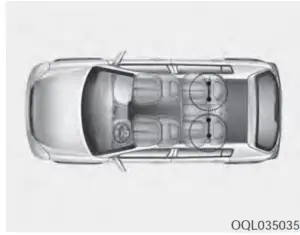
LATCH anchors have been provided in the left and right outboard rear seating positions. Their locations are shown in the illustration. There are no LATCH anchors provided for the center rear seating position.
WARNING
LATCH Lower Anchors
Never attempt to attach a LATCH-equipped seat in the center seating position. LATCH lower anchors are only to be used in the left and right rear outboard seating positions. You may damage the anchors or the anchors may fail and break in a collision.
The lower anchor position indicator symbols are located on the left and right rear seat backs to identify the position of the lower anchors in your vehicle (see arrows in illustration).
The LATCH anchors are located between the seatback and the seat cushion of the rear seat left and right outboard seating positions.
To use the lower anchor, push the upper portion of the lower anchor cover.
- Lower Anchor position indicator
- Lower Anchor
Securing a child restraint with the LATCH anchors system
To install a LATCH-compatible child restraint in either of the rear outboard seating positions:
- Move the seat belt buckle away from the lower anchors.
- Move any other objects away from the anchors that could prevent a secure connection between the child restraint and the lower anchors.
- Place the child restraint on the vehicle seat, then attach the seat to the lower anchors according to the instructions provided by the child restraint manufacturer.
- Follow the child restraint instructions for properly adjusting and tightening the lower attachments on the child restraint to the lower anchors.
WARNING
Take the following precautions when using the LATCH system:
- Read and follow all installation instructions provided with your child restraint system.
- To prevent the child from reaching and taking hold of unrestricted seat belts, buckle all unused rear seat belts and retract the seat belt webbing behind the child. Children can be strangled if a shoulder belt becomes wrapped around their neck and the seat belt tightens.
- NEVER attach more than one child restraint to a single anchor. This could cause the anchor or attachment to come loose or break.
- Always have the LATCH system inspected by your authorized Kia dealer after an accident. An accident can damage the LATCH system and may not properly secure the child restraint.
NOTICE
The recommended maximum weight for the LATCH system is 65 lbs. (30 kg). When selecting a proper child restraint, consider that the maximum total weight of the child plus the child restraint should be less than 65 lbs (30 kg).
As a guide, the MAX child restraint weight should be determined by the following calculation:
Child Restraint Weight = 65 – (child’s total weight in lbs.)
Securing a child restraint seat with “Tether Anchor” system
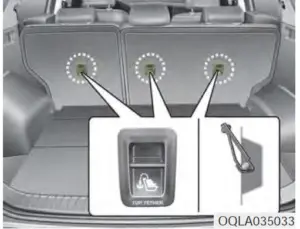
First secure the child restraint with the LATCH lower anchors or the seat belt. If the child restraint manufacturer recommends that the top tether strap be attached, attach and tighten the top tether strap to the top tether strap anchor.
Child restraint system top tether anchorages are located on the back of the rear seatbacks.
WARNING
Take the following precautions when installing the tether strap:
- Read and follow all installation instructions provided with your child restraint system.
- NEVER attach more than one child restraint to a single tether anchor. This could cause the anchor or attachment to come loose or break.
- Do not attach the tether strap to anything other than the correct tether anchor. It may not work properly if attached to something else.
- Do not use the tether anchors for adult seat belts or harnesses, or for attaching other items or equipment to the vehicle.
- Always fasten the seatbelts behind the child restraint seat when they are not used to secure the child seat. Failure to do so may result in child strangulation.

To install the tether anchor:
- Route the child restraint tether strap over the child restraint seat-back. Route the tether strap under the head restraint and between the head restraint posts, or route the tether strap over the top of the vehicle seatback. Make sure the strap is not twisted.
- Connect the tether strap hook to the tether anchor, then tighten the tether strap according to the child seat manufacturer’s instructions to firmly secure the child restraint to the seat.
- Check that the child restraint is securely attached to the seat by pushing and pulling the seat forward and from side to side.
2023 KIA SPORTAGE Specs, Price, Features, Mileage and Torque
Securing a child restraint with a lap belt or lap/shoulder belt
When not using the LATCH system, all child restraints must be secured to a vehicle rear seat with the lap part of a lap/shoulder belt.
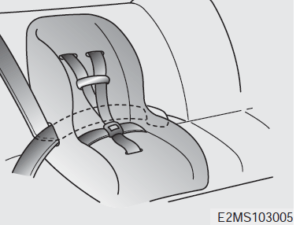
Automatic locking mode
Since all passenger seat belts move freely under normal conditions and only lock under extreme or emergency conditions (emergency locking mode), you must manually pull the seat belt all the way out to shift the retractor to the “Automatic Locking” mode to secure a child restraint.
The “Automatic Locking” mode will help prevent the normal movement of the child in the vehicle from causing the seat belt to loosen and compromise the child restraint system. To secure a child restraint system, use the following procedure.
To install a child restraint system on the rear seats, do the following:
- Place the child restraint system on a rear seat and route the lap/ shoulder belt around or through the child restraint, following the restraint manufacturer’s instructions.
Be sure the seat belt webbing is not twisted.
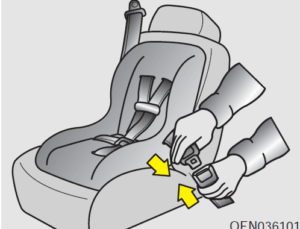
- Fasten the lap/shoulder belt latch into the buckle. Listen for the distinct “click” sound.
Position the release button so that it is easy to access in case of an emergency.
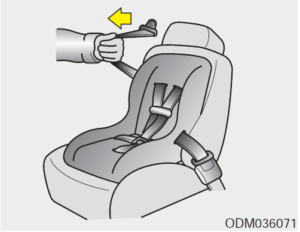
- Pull the shoulder portion of the seat belt all the way out. When the shoulder portion of the seat belt is fully extended, it will shift the retractor to the “Automatic Locking” (child restraint) mode.

- Slowly allow the shoulder portion of the seat belt to retract and listen for an audible “clicking” or “ratchet-ing” sound. This indicates that the retractor is in the “Automatic Locking” mode. If no distinct sound is heard, repeat steps 3 and 4.
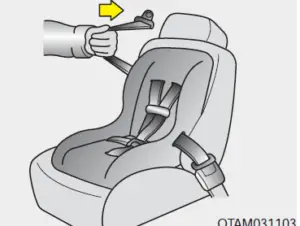
- Remove as much slack from the belt as possible by pushing down on the child restraint system while feeding the shoulder belt back into the retractor.
- Push and pull on the child restraint system to confirm that the seat belt is holding it firmly in place. If it is not, release the seat belt and repeat steps 2 through 6.
- Double-check that the retractor is in the “Automatic Locking” mode by attempting to pull more of the seat belt out of the retractor. If you cannot, the retractor is in the “Automatic Locking” mode.
NOTICE
When the seat belt is allowed to retract to its fully stowed position, the retractor will automatically switch from the “Automatic Locking” mode to the emergency lock mode for normal adult usage.
WARNING
Auto lock mode
Set the retractor to Automatic Lock mode when installing any child restraint system. If the retractor is not in the Automatic Locking mode, the child restraint can move when your vehicle turns or stops suddenly.
To remove the child restraint, press the release button on the buckle and then pull the lap/shoulder belt out of the restraint and allow the seat belt to retract fully.
FAQs
How many child seats can the Kia Sportage accommodate?
The Kia Sportage typically has two rear seat positions equipped with LATCH (Lower Anchors and Tethers for Children) anchors for securing child seats. It can typically accommodate two child seats in the rear, but it’s essential to consult the vehicle’s manual for specific details.
Can I use both LATCH anchors and seat belts to secure a child seat in the Kia Sportage?
Yes, you can typically choose to secure a child seat using either the LATCH anchors or the vehicle’s seat belts. However, it’s important to follow the manufacturer’s instructions for the specific child seat you’re using and ensure a secure installation.
What is the weight and height limit for rear-facing and forward-facing child seats in the Kia Sportage 2022?
The weight and height limits for child seats can vary depending on the specific child seat model and the regulations in your region. Refer to both the child seat manufacturer’s guidelines and the vehicle’s owner’s manual for this information.
How do I deactivate the front passenger airbag for a rear-facing child seat?
The Kia Sportage 2022 typically has a switch or sensor that allows you to deactivate the front passenger airbag when using a rear-facing child seat. Consult your owner’s manual for specific instructions on how to do this.
Can I install a booster seat for an older child in the Kia Sportage?
Yes, you can install a booster seat in the Kia Sportage for older children who have outgrown a forward-facing child seat. Make sure to follow the booster seat manufacturer’s guidelines for proper installation and use.
Are there any additional safety features for child passengers in the Kia Sportage?
The Kia Sportage may offer features like rear door child safety locks, rear window sunshades, and rear seat belt reminders to enhance child passenger safety. Consult the owner’s manual and check the vehicle’s specific features to know more.
Are there any child passenger safety inspections or checks offered by Kia dealerships?
Some Kia dealerships may offer child passenger safety inspections or checks to ensure that child seats are properly installed in your vehicle. Contact your local dealership for information on available services.
Can I use an aftermarket child seat cover or padding in the Kia Sportage’s CRS?
It’s generally recommended to avoid using aftermarket accessories, such as seat covers or padding, with child seats. These accessories can interfere with the proper installation and safety of the child seat. Stick to manufacturer-approved accessories.
What should I do if my child outgrows the weight or height limits of their car seat while still needing one for safety?
If your child exceeds the weight or height limits of their current car seat, it’s essential to transition them to an appropriate seat that accommodates their size. Consult the child seat manufacturer’s guidelines and consider a booster seat if necessary.
Are there any specific child seat placement recommendations for multiple children in the vehicle?
If you have multiple children requiring car seats, the specific placement can depend on factors like their age, size, and the available seating positions with LATCH anchors. Ensure that each child’s car seat is correctly installed and meets safety requirements.
Useful Link
View Full User Guide: Kia Sportage 2022 User Guide
Download Manuals: https://owners.kia.com/content/owners/en/manuals.html
2023 KIA SPORTAGE Specs, Price, Features, Mileage and Torque

